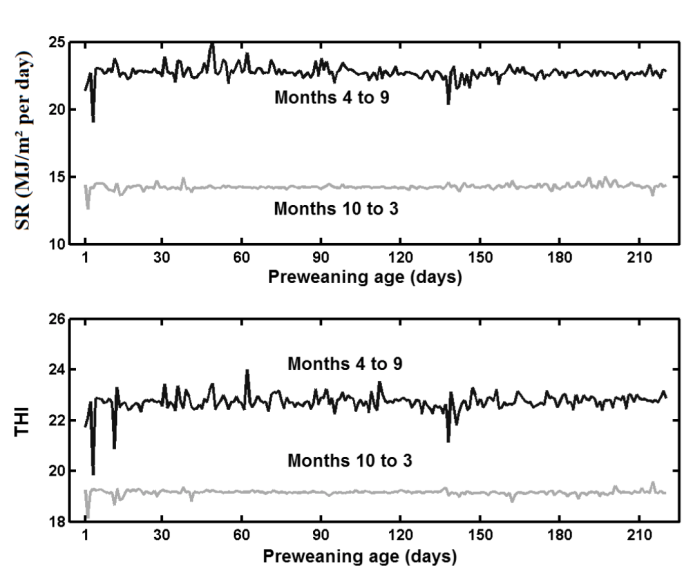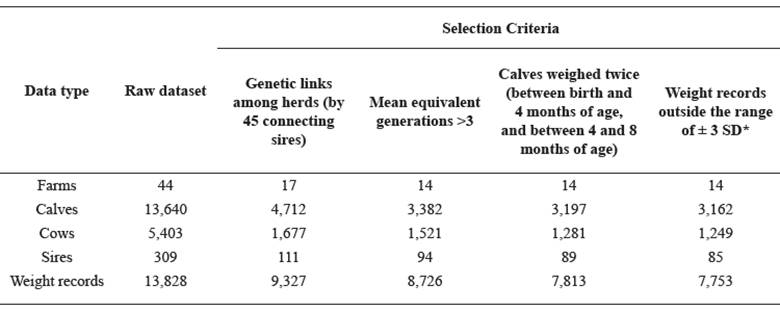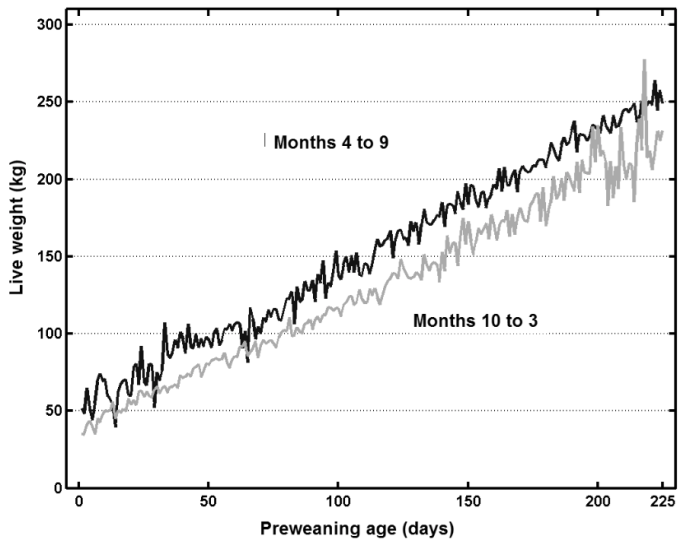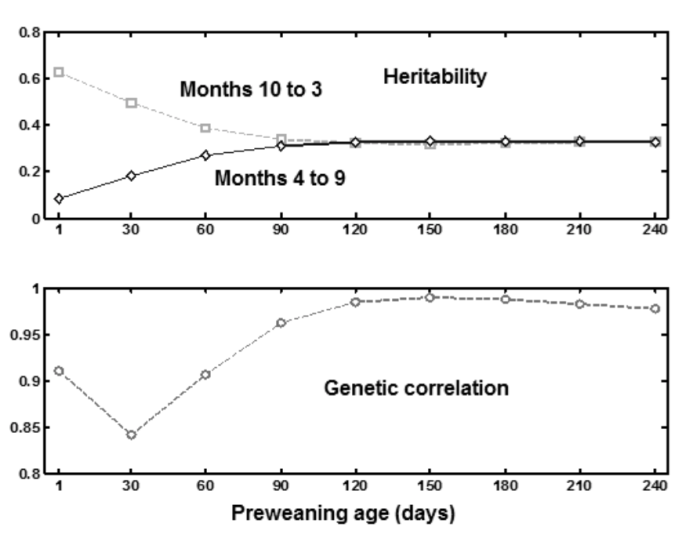Introduction
Extensive livestock production is highly dependent on weather conditions. Nowadays, cattle reared under extensive conditions are exposed to increasing heat stress, which is expected to worsen in the next decades (IPCC, 2014). Such an adverse situation is partially solved by using autochthonous breeds since they are better adapted to the local environment.
In cattle, heat stress has been associated with decreased productivity and economic losses (Mader, 2003; Nienaber and Hahn, 2007; St-Pierre et al., 2003), normally induced by reduced feed intake (Collier and Zimbelman, 2007). In extreme cases, heat stress has been associated with negative energy balance and body weight loss (Lacetera et al., 1996), as well as with a reduced immune system response (Silanikove, 2000). The first experimental approach to select animals based on heat stress tolerance was proposed by Misztal (1999). This researcher evaluated the productive reaction of individuals subjected to increasing heat loads (reaction-norm model) to determine the genotype-environment interaction and detect the best genetically adapted individuals to an increased temperature range (Santana et al., 2016). Later, heat stress tolerance was included as a secondary trait in dairy selection schemes focused on increased production (Bohmanova et al., 2005; Brugemann et al., 2011; Carabano et al., 2017; Ravagnolo and Misztal, 2000; Sanchez et al., 2009). However, few studies have been performed in Bos taurus (Bradford et al., 2016) and Bos indicus (Santana et al., 2016) grazing cattle, and -to our knowledge-no studies have been performed in Spanish breeds.
Retinta is an autochthonous breed widely used in the south of Spain due to its excellent adaptation to the extreme environment that prevails in that region (Morales et al., 2013). These individuals are raised in an extensive regime characterized by pasturelands with limited production, steep hills and a dry and hot climate (Rodero-Serrano et al., 2013). Under these herd conditions, the effect of heat stress is expected to rapidly manifest as weight loss and reduced reproductive potential in poorly adapted individuals (Vercoe and Frisch, 1980).
Therefore, the objective of this study was to develop a novel methodological approach to determine the influence of weather variables on the estimation of genetic parameters for growth traits in Retinta cattle by random regression (reaction-norm) models.
Materials and methods
Animals and growth records
Growth records of 3,162 calves born from 85 sires and 1,249 cows were collected between birth and 245 days of age. All calves were weighed at least once between birth and 4 months of age, and at least another time between 4 to 8 months of age. The animals belonged to 14 Retinta herds located in the south of Spain and were reared during a nine-year period (two-generation intervals). Farms were selected to maximize the pedigree completeness, more than 3 mean equivalent generations (Maignel et al., 1996), production records and the genetic links among herds, which was achieved by using insemination with 45 connecting sires. Weight records outside the range of ± 3 standard deviations from the average were excluded, resulting in 7,753 live weight records from calves included in this study (Table 1). The relationship matrix (A) included a pedigree with a total of 6,053 animals and their ancestors. This genealogical records information was obtained from the herdbook of the Retinta Breeder’s Association. Mean maximum generation was 11.70, mean complete generation was 3.79, and mean equivalent generation was 6.27, as determined by ENDOG (Gutiérrez and Goyache, 2005).
Climate data
Climate data were obtained from four weather stations of the Spanish Meteorological State Agency (Agencia Estatal de Meteorología- AEMET), located near the farms. Weather stations collect climatic information (temperature, relative humidity, degree of insolation, solar radiation, precipitation, and speed and wind direction) every hour. From this information, the average temperature and humidity were calculated to estimate the temperature and humidity index (THI), according to Finocchiaro et al. (2005) as:
Where Tdb = dry bulb temperature (°C) and RH = relative humidity of the air (%).
Solar radiation (SR; MJ/m² per day) was also registered to define the annual variation and determine the existence of weather seasons based on systematic records.
The herd heat load was estimated as the average THI 30 days before each weight assessment.
Reaction-norm model
Individual live weight results recorded during the high heat stress (HHS) and low heat stress (LHS) seasons were considered as two different traits. The components of variance through the trajectory of the pre-weaning age intra-stress zone were estimated applying a bi-character random regression model:
where yijkl:Z is the ith records of live weight in each z stress zone; fixed is a set of fixed effects: sex of the calf with two levels (Sj j=2 level), parity effect of the dam with ten levels (CNk, k = 1, 2,…6 or more calvings) and combined herd-year with 355 levels. Age effects were analyzed by a fixed covariable intra-stress zone (z) by a Legendre polynomial (F) of order r = 3.
Genetic effects (ai) were calculated by a random regression matrix (lk) intra-stress zone with a Legendre polynomial (F) of order r = 1; Z1 is an incidence matrix of permanent environmental random effects (pi) due to repetitions of the same trait in the animal, and eijkl is a random error common to all observations. A residual intra-stress zone variance was evaluated, but it did not contribute to an increase in the model fit.
The significance of the effects included in the model was determined with the Wald test (Kenward and Roger, 1997). All the statistical analyses were carried out using the Asreml software (Gilmour et al., 2009).
In this reaction-norm animal model, the variance can be estimated as follows:
Where A is the numerator relationship matrix, Ips2p and Ins2e are the variances of permanent environmental random effects and residual effect, with matrices of identity Ip and In, respectively. These variance components are given directly by Asreml, while the expected (co)variance components through different ages of the cow for each stress-zone can be represented by a further random regression matrix manipulation lk:zwith the following four sub-matrices:
The diagonal sub-matrix elements (lhy ll) are used to estimate the variances of live weight over pre-weaning age under HHS and LHS environmental conditions, symbolized as h and l, respectively, while the correspondent (co)variances are contained in lhl = llh. The (co)variance estimates were obtained applying the procedure proposed by Jong (1995). Details of practical application with data of this breed were recently presented by Morales et al. (2013). Heritability at j age and genetic correlations between any pair of ages in both stress zones were determined by classical methodologies.
Results
The analysis of the weather data collected during a nine-year period showed two well-differentiated periods with minimal variations within each period: a warm season from April to September (HHS) and a cold season from October to March (LHS). The former was characterized by a 40% increased SR, and 20% increased THI compared with LHS (Figure 1).

Figure 1 Progression of temperature, humidity (THI), and solar radiation (SR) index during pre-weaning growth of Retinta cattle in two climatic categories, warm or high heat stress (HHS) from months 4 to 9, and cold or low heat stress (LHS) from month 10 to 3 years of age.
All the included effects were highly significant (p<0.001, Wald test), as well as weather-season-age of the calf interaction. Differences in the progression of live weight during the pre-weaning age trajectory of Retinta calves and each climatic class were significant (p<0.001, Wald test) (Figure 2).
Live weight variance components and heritabilities were estimated in each climatic season during the pre-weaning period, showing a wide range of variation throughout the calf's age. Heritability differences in the HHS and LHS zones were highly significant during the first 90 days of growth (p<0.001, Wald test). After this point (end of the third month), differences were not significant (p>0.05), converging to zero after 120 days of growth (Figure 3). Likewise, the genetic correlations of live weights in the different climatic periods showed the same trend, with values lower than 1 during the first three months of age, and close to 1 thereafter (Figure 3).
Discussion
In this study, we aimed to demonstrate the flexibility and potentiality of reaction-norm random regression models to evaluate the genotype-environment interaction in extensive cattle production systems. Despite of not including some environmental factors in this analysis (e.g., nutritional management, livestock load per acre, or grazing strategies) and the weather analyzed included only the Mediterranean climate range (CSA, according to the Köppen-Geiger climate classification; Kottek et al., 2006) our results showed the existence of a genetic influence on weaning weight under stressful environmental conditions. In addition, climatic conditions could have a strong influence on weight increase, particularly during the first months of life. However, the genetic correlation with climatic periods lower than 1 in the first three months of age suggests the existence of a highly significant interaction between the environment and the calf genotype in that specific period.
In this study, we used an analytical methodology previously reported in dairy cattle (Aguilar et al., 2009; Ravagnolo and Misztal, 2000) and swine (Fragomeni et al., 2015; Zumbach et al., 2008) raised in confined systems, in which the environmental conditions were tightly controlled, with minimum variation among farms. On the other hand, Retinta cattle are raised in the typical environment of the south of Spain and the Andalucía region, characterized by harsh weather, cold winters and dry and hot summers, with abrupt changes between seasons. In our case, reaction-norm models proved to be valid to evaluate the heat-stress tolerance of grazing animals under such conditions, which is extremely important since those individuals are more prone to be exposed to heat stress (Tucker et al., 2008).
In a previous study, Bradford et al. (2016) determined a heritability close to 0.24 for weaning weight in Angus cattle using reaction-models with intermediate heat loads. On the contrary, the results obtained with calves raised under more favorable environmental conditions and in zebu cattle were higher (Cardoso and Tempelman, 2012; Santana et al., 2016). In our study, heritabilities showed a wide range of variation throughout the calves´ age, which could be partially explained by differences in heat stress tolerance among individuals’ age or by differences in the availability and quality of pasturelands that influences milk production. However, it has also been demonstrated that milk production is severely affected by individual heat stress tolerance, suggesting that those animals could be affected not only by the heat stress tolerance of their genotype, but also by the genotype of their mother (Aguilar et al., 2009; Bohmanova et al., 2005; Carabano et al., 2014; Sanchez et al., 2009). Likewise, it is noteworthy that genetic correlations between climatic periods were extremely high during the last period of growth of the calf, in which the dependence on maternal milk is much lower.
Despite the overall interaction was not significant, genetic differences between climatic seasons were significant at specific growth periods. This phenomenon was also recently described by Santana et al. (2016), who observed substantial heterogeneity in the (co)variance components for weaning weight analyzing different environmental conditions, suggesting that it was an evidence of the genotype-environment interaction. Moreover, those researchers demonstrated that the best-fitted animals detected in the least stressful environments were not necessarily the most suitable ones, and even not suitable at all, to be raised in the most stressful environments. In our study, individuals that grew up in HHS suffered a highly stressful environment in comparison with the group reared in LHS. Nevertheless, the number of records analyzed in each category was homogeneous, suggesting that Retinta calves are well adapted to the environmental conditions observed in HHS.
Based on the current knowledge, low response to selection for weaning weight in populations reared under stressful environments is expected, since greater growth appeared from 70 to 160 days in animals raised during the cold season (Figure 2). However, differences were not significant when they were considered altogether, suggesting the existence of a compensatory growth that equalizes calf weights after this age. It is also known that the dam begins to reduce milk production during pre-weaning, thus forcing the calf to consume grass, thus the genotype-environment interaction would be more evident during this specific period. Therefore, our results suggest that the effect of calving season and heat load could be exerted through the grazing behavior of the calf, which is clearly associated with thermal stress (Santana et al. 2016).
In conclusion, differences observed in the heritability pattern of individuals reared in diverse environments during the first 90 days of age were not significant at the end of the growing period. Our results confirm a clear variability among individuals since animals raised during the cold season showed a greater growth from 70 to 160 days. This information could be used as a baseline for future studies including ample range of rearing environments as well as the nutritional impact produced by environmental differences.





















